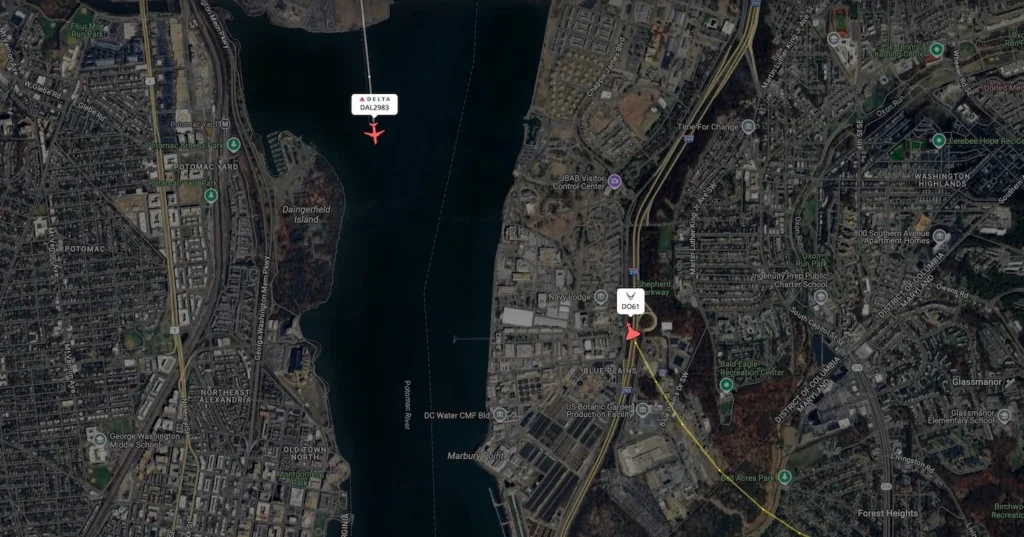Delta Flight’s Near Miss with Air Force Jet at Reagan National Airport
A Delta Air Lines Airbus A319 carrying 137 passengers came dangerously close to colliding with a U.S. Air Force T-38 jet in the vicinity of Ronald Reagan Washington National Airport. The incident occurred just minutes after takeoff as the Delta flight, en route to Minneapolis-St. Paul, received an onboard alert signaling the proximity of another aircraft. The sudden alarm prompted immediate action from the cockpit crew, who relied on their training and instruments to assess the potential danger.
Alarming Proximity and Swift Response
Tracking data indicates that the military jet flew past the Delta aircraft at a speed exceeding 350 miles per hour, coming within 800 feet of the commercial plane. Such an event can be classified as a severe aviation safety incident, as standard separation measures are typically far greater to ensure passenger safety. The Federal Aviation Administration (FAA) confirmed that air traffic controllers issued immediate corrective instructions to both aircraft, preventing a potential catastrophe.
As recorded by air traffic control communications on LiveATC.net, a Delta pilot was overheard inquiring, “Was there an actual aircraft roughly 500 feet below us?” to which a controller responded, “Affirmative.” The exchange underscores the alarming proximity between the two planes and raises questions about how such a situation developed despite existing air traffic control measures.
Military Flyover and FAA Investigation
The U.S. Air Force later clarified that the T-38 jet, along with three other military aircraft, was in the area for a scheduled flyover at Arlington National Cemetery. The flyover was part of a ceremonial tribute, a routine practice that typically involves extensive coordination with local air traffic authorities. However, despite the planned flight path, the unexpected close encounter raised concerns over airspace coordination and communication between military and civilian aviation authorities.
Following the incident, the FAA announced an investigation into the near miss. In an official statement, the agency confirmed, “The Delta aircraft received an onboard alert indicating the presence of another nearby aircraft.” Air traffic controllers issued corrective instructions to both aircraft.” The investigation aims to determine whether procedural lapses, communication breakdowns, or unexpected deviations contributed to the incident.

Mounting Concerns Over Aviation Safety
This near miss comes just months after a tragic mid-air collision near the same airport, which resulted in 67 fatalities. The incident has reignited concerns about the risks of congested airspace, particularly in the Washington D.C. metropolitan area, which frequently experiences high volumes of both commercial and military aircraft operations. Recent data from the National Transportation Safety Board (NTSB) reveals a staggering 15,214 near-miss events between aircraft and helicopters in U.S. airspace from October 2021 to December 2024. Additionally, 85 cases were recorded where aircraft had dangerously close lateral and vertical separations, sometimes mere seconds away from catastrophe.
During a recent Senate hearing, lawmakers raised concerns over increasing aviation close calls, demanding stricter safety protocols and enhanced air traffic management systems. Senator Amy Klobuchar, who has been vocal about airline safety in the past, stated, “The increasing frequency of these near misses is unacceptable. The FAA and military must work together to prevent another disaster.” Lawmakers are now urging for immediate improvements in air traffic control modernization, real-time aircraft tracking capabilities, and pilot communication systems.
Delta Air Lines’ Response
Following the incident, Delta Air Lines issued a statement reaffirming their dedication to passenger safety, stating, “The safety of our customers and employees is our top priority.” We will cooperate with regulators and aviation stakeholders in any review of this flight.” The airline has also reassured passengers that pilots undergo rigorous training for potential in-flight emergencies, including evasive maneuvers and immediate response to onboard alarms.
Aviation safety experts have weighed in on the incident, stressing the importance of continuous training and updated air traffic control systems. John Mitchell, an aviation safety consultant, noted, “Technology and procedures exist to prevent these incidents, but human errors and coordination lapses still pose serious risks. Real-time monitoring improvements are necessary to prevent near misses from becoming tragedies.”
With the FAA’s investigation underway, aviation experts stress the need for enhanced air traffic monitoring systems, improved coordination between commercial and military aircraft, and updated airspace management policies to prevent similar occurrences in the future. As investigations proceed, regulatory agencies and airline companies alike will likely implement new measures to reinforce aviation safety standards.
For further updates on aviation safety, stay tuned to our latest reports.


